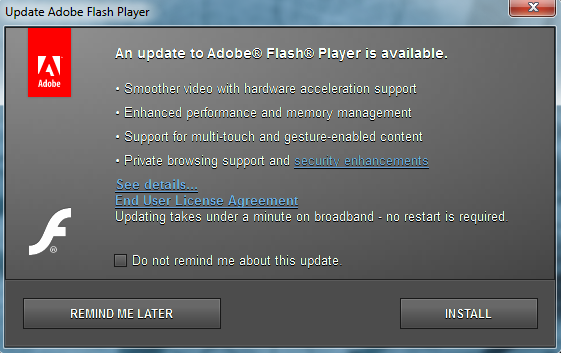Summary:
- This vulnerability affects: Adobe Flash Player 11.6.602.168 and earlier, running on all platforms
- How an attacker exploits it: By enticing users to visit a website containing malicious Flash content
- Impact: In the worst case, an attacker can execute code on the user’s computer, potentially gaining control of it
- What to do: Download and install the latest version of Adobe Flash Player (version 11.6.602.171 for PC and Mac)
Exposure:
Adobe Flash Player displays interactive, animated web content called Flash. Although Flash is optional, 99% of PC users download and install it to view multimedia web content. It runs on many operating systems, including mobile operating systems like Android.
 In a security bulletin released yesterday, Adobe announced a patch that fixes three critical zero day vulnerabilities in their popular Flash Player; two of which attackers are currently exploiting in the wild.
In a security bulletin released yesterday, Adobe announced a patch that fixes three critical zero day vulnerabilities in their popular Flash Player; two of which attackers are currently exploiting in the wild.
The three vulnerabilities differ technically. For instance, one is a buffer overflow flaw and another is a sandbox bypass vulnerability. However, combined they share the same general impact. If an attacker can entice one of your users to visit a malicious website, or into handling specially crafted Flash (SWF of FLV) content, he could exploit these flaws to execute code on that user’s computer, with that user’s privileges. If your users have administrator privileges, the attacker could gain full control of their computers.
According to Abobe’s alert, the exploits for these vulnerabilities target the Firefox web browser running on Windows systems, which is why they rate this a “Priority 1” issue for Windows, and recommend you apply the updates as soon as possible (within 72 hours). However, the vulnerability technically affects other platforms as well, so I recommend you update any Flash capable device as soon as you can.
Solution Path
Adobe has released new versions of Flash Player (11.6.602.171 for PC and Mac) to fix these issues. If you allow Adobe Flash in your network, you should download and install the new versions immediately. If you’ve enabled Flash Player’s recent “silent update” option, you will receive this update automatically.
- Download Flash Player for your computer:
For All WatchGuard Users:
If you choose, you can configure the HTTP proxy on your XTM appliance to block Flash content. Keep in mind, doing so blocks all Flash content, whether legitimate or malicious.
Our proxies offer many ways for you to block files and content, including by file extension, MIME type, or by using very specific hexidecimal patterns found in the body of a message – a technique sometimes referred to as Magic Byte detection. Below I list the various ways you can identify various Flash files:
File Extension:
- .swf – Shockwave
- .flv – Adobe Flash file (file typically used on websites)
- .fla – Flash movie file
- .f4v – Flash video file
- .f4p – Protected Flash video file
- .f4a – Flash audio file
- .f4b – Flash audiobook file
MIME types:
- video/x-flv
- application/x-shockwave-flash
- application/x-shockwave-flash2-preview
- application/futuresplash
- image/vnd.rn-realflash
FILExt.com reported Magic Byte Pattern:
- Hex SWF: 46 57 53
- ASCII SWF: FWS
(Keep in mind, not all the Hex and ASCII patterns shared here are appropriate for content blocking. If the pattern is too short, or not unique enough, blocking with them could result in many false positives)
If you decide you want to block Flash files, the links below contain instructions that will help you configure your Firebox proxy’s content blocking features using the file and MIME information listed above.
- XTM Appliance with WSM 11.x
- Firebox X Edge running 10.x
- Firebox X Core and X Peak running Fireware 10.x
Status:
Adobe has released updates to fix these Flash vulnerabilities.
References:
This alert was researched and written by Corey Nachreiner, CISSP (@SecAdept)

Leave a Reply